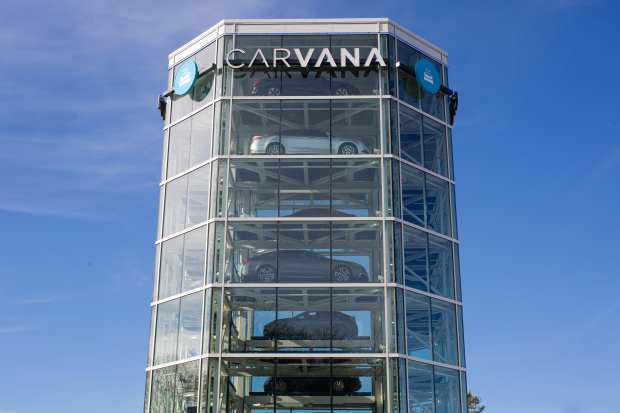Car Vending Machine Company Carvana Goes Up Against Wall Street

Wall Street is a tough master, especially for eCommerce companies. Just ask Carvana, the leading online automotive seller and a major force in changing the way people buy cars. Its fourth-quarter earnings report, released at the end of February, showed a revenue jump of 88 percent from 2019 to $1.1 billion, on an 82 percent increase in retail sales.
Apparently that will get you in trouble on the Street. The analyst community balked at longer-term questions about the company’s liquidity even though 2019 was the company’s sixth straight year of triple-digit revenue growth with over 177,000 cars delivered and just shy of $4 billion in revenue.
“During the year, we delivered more cars to our customers than we had in our entire prior history combined, but it isn’t just the percentage growth that is noteworthy. At this scale that growth rate means we sold an incremental 83,000 cars this year,” said Ernie Garcia, president, chief executive officer and chairman, on the earnings call. “That is the most organic growth of any automotive retailer ever in the U.S. This year we expect another year of market-leading growth. The powerful unit economics inherent in our model continue to show up consistently. In 2019, we increased GPU by $750. Even more remarkably, it was our sixth straight year of over $400 of improvement in that metric. This year we expect to notch our seventh.”
Noting that existing Carvana markets grew by 84 percent, he said, “The company’s four oldest markets each more than three years old grew by 50 percent and our oldest cohort of Atlanta grew by 18 percent. Our cohort growth was broad based with many markets crossing key milestones.”
However, expenses didn’t come down enough for the Street and Carvana was torched in many cases. For example, as reported by Forbes, auditor Grant Thornton wrote that “management believes” it can meet its financial obligations through February 2021. This belief is based on “the Company’s operating plan, that current working capital and expected continued inventory and capital expenditure financing is sufficient to fund operations and satisfy the Company’s obligations.”
“Grant Thornton does not share management’s confidence in that operating plan,” according to Forbes, quoting Thornton as saying, “We determined the Company’s ability to continue as a going concern is a critical audit matter due to the estimation and execution uncertainty regarding the Company’s future cash flows and the risk of bias in management’s judgments and assumptions in estimating these cash flows.”
But Carvana is bullish. What once started as a gimmick — its car vending machine — has become an engine for driving marketing, publicity and growth in the markets where it opens. According to Carvana Chief Brand Officer Ryan Keeton, opening new markets brings an uptick in overall business.
“We see interest grow when we launch in new markets — 161 to date — and when we launch new Car Vending Machines (currently in 24 cities); our most recent being Miami,” said Keeton. “Additionally, we’re invested in the communities in which our employees live and work, so when we participate in a charity walk or do one of our coffee shop takeovers, where we buy everyone’s coffee for a day, there’s certainly increased interest in the brand.”
New Markets
The Miami vending machine has a new design and is definitely an attention-getter in new markets. To pick up a Carvana-purchased vehicle, the customer drops a customized “coin” into the slot, which activates the eight-story vehicle delivery system. The machine picks the vehicle from the tower and brings it to a delivery bay. Once in the bay, the customer has seven days to drive the car around town before ultimately deciding if the vehicle is right for them.
Miami is Carvana’s 24th car vending machine location to date — joining Nashville, San Antonio, Houston, Austin, Dallas, Raleigh, Jacksonville, Tampa, Charlotte, Washington, D.C., Orlando, Tempe, Cleveland, Philadelphia, Indianapolis, Pittsburgh, Chicago, Kansas City, Greensboro, Westminster (L.A.), Ontario (L.A.), Oklahoma City, and Memphis. It is only part of a stepped-up marketing effort.
“Buying a car is a considered purchase, so we’ve taken an omnichannel approach that spans the messaging journey from awareness, to education, all the way to word-of-mouth/advocacy of our customers,” said Keeton. “We combine traditional advertising channels like TV and OOH, along with digital channels like listing sites, social media, SEM and others, to tell the story of Carvana, as well as communicate our differentiation from and advantages compared to the traditional way to buy a car at a dealership: Carvana offers a great selection (a national inventory of 25,000+ vehicles) at a great price (the average customer can save thousands compared to the dealership), with a great experience (no salespeople and a 7-day return policy). Most importantly, with our focus on exceptional customer experiences, those happy customers become the most credible resource for other car buyers in their spheres of influence.”
Garcia said the firm is in a good position. “We’re coming in with a really big inventory that’s very diverse, more diverse than any inventory we’ve ever had,” said Garcia. “I think what we’re always trying to do is appropriately size the business to be able to handle the volume that we see today and hopefully be able to quickly flex to handle the volume that we see as we move through these high-volume times. I think we’re really well positioned. We’re obviously growing extremely fast. We’ll be keeping a close eye on [growth] … if we start to constrain in different places and we’ll be reacting just like we have in the past.”
